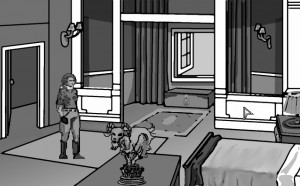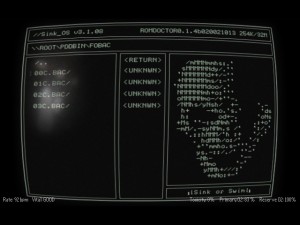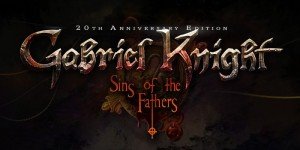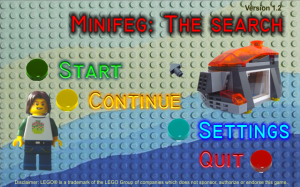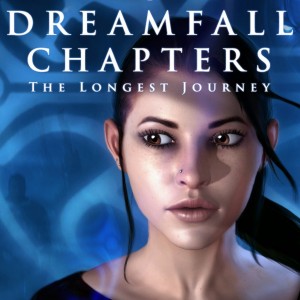Following Freeware - September 2015 releases
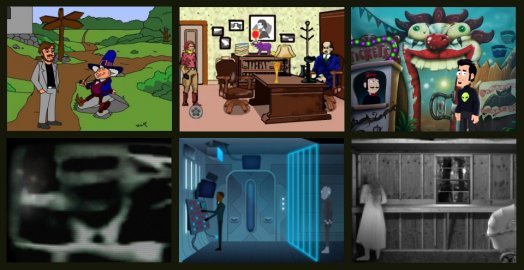
This month you can go back to the 1920s as an aviatrix in the film industry or forward to the far future as a man trapped on a crippled spaceship. Horror fans can pursue a serial killer through a castle, or uncover supernatural happenings out in the woods. Those into IT can become a hacker breaking into a computer against the clock or a game reviewer who gets too immersed in the latest release. Alternatively, you can get three games in one in a collected trio of little sci-fi tales. All these await in this month’s round-up of releases from the freeware scene.
Steve’s Selections
The Boogie Man
Detective Keith Baring is obsessed with his job. He has become distant from his wife and has started adopting increasingly harsh methods to bring criminals down. When his latest case attracts unwelcome media attention, the chief of police orders him to take a holiday. Not only that, he provides tickets for Keith and his wife to stay in a new resort at a remote castle. But this vacation proves to be no rest cure for Keith. In the middle of the night, his wife and the other guests are taken by the mysterious Boogie Man. Only by playing this twisted fiend at his own game will Keith see any of them alive again.
 Uri’s The Boogie Man is a dark tale with new horrors lurking around every corner. This is not a game for the young or faint-hearted, as there is a significant amount of gore and other horrific occurrences. The main graphical view is a top-down retro role-playing game style. The majority of time is spent in the castle, with its rough stone walls and corridors. The decorations vary, from the comparative comfort of the guest rooms with plush seating to a storeroom covered in blood. The action largely takes place in the dark, so only the area immediately around the protagonist is clearly visible whilst indoors. Though small and moderately pixelated, the characters have enough distinct features to be individually identifiable. Occasionally there are still images rendered in a more detailed manga style for important story cutscenes. For much of the game there is no music, with only a soft whispering wind or, where appropriate, running water. The exceptions involve the appearances of the Boogie Man, who likes theatrical music to back him up, and action music for some of the more dramatic sequences. The game is far from silent though, with footsteps echoing on the floor, creaking doors and a multitude of unpleasant sound effects when helping the villain’s victims. The game is also fully voiced, with the Boogie Man especially providing a disturbingly effective performance.
Uri’s The Boogie Man is a dark tale with new horrors lurking around every corner. This is not a game for the young or faint-hearted, as there is a significant amount of gore and other horrific occurrences. The main graphical view is a top-down retro role-playing game style. The majority of time is spent in the castle, with its rough stone walls and corridors. The decorations vary, from the comparative comfort of the guest rooms with plush seating to a storeroom covered in blood. The action largely takes place in the dark, so only the area immediately around the protagonist is clearly visible whilst indoors. Though small and moderately pixelated, the characters have enough distinct features to be individually identifiable. Occasionally there are still images rendered in a more detailed manga style for important story cutscenes. For much of the game there is no music, with only a soft whispering wind or, where appropriate, running water. The exceptions involve the appearances of the Boogie Man, who likes theatrical music to back him up, and action music for some of the more dramatic sequences. The game is far from silent though, with footsteps echoing on the floor, creaking doors and a multitude of unpleasant sound effects when helping the villain’s victims. The game is also fully voiced, with the Boogie Man especially providing a disturbingly effective performance.
Control is done through the keyboard, with arrow keys to move and Z to interact with whatever Keith is facing. X opens a small menu that allows access to the inventory, from which you can select an item to use instead. At the start of the game you will only have a small part of the castle to explore, most of which you will have seen in the relatively gentle introduction. As you progress, you will achieve greater heights and depths as you unlock doors and secret passageways. You will acquire a modest inventory, often in quite unpleasant fashion, and will need to be creative in your use of much of it. There are also secret codes to resolve and strange machines to operate. The latter are often creations of the Boogie Man, set to kill you or others. Whilst you will usually have some advance warning, it is advisable to save your game regularly as sudden death is a frequent possibility. The same is true for your fellow guests, and there are a couple of times when you will be working against the clock to save someone from a gruesome end. The story comes out naturally over the course of the game, with the reason for Keith’s obsessive behaviour becoming a key factor. There are five available endings, mostly determined by whether some of the other characters live or die.
The Boogie Man can be downloaded from the developer’s website.
Editor's Note: This game was originally credited to the wrong developer. We have since corrected the error. Sorry, Uri!
Jacqueline White: Bad Trouble in the Red Desert
It is the 1920s and the action film industry is booming. For aviatrix Jacqueline White, this is a great opportunity. Not only does she take cameras aloft to capture aerial shots of the action, she even gets to take part herself. Signed up for the latest movie from Two Bad Pennies studio, her work takes her to a popular film location, a desert with an abandoned mine. But unexplained accidents have been putting other crews out of business recently. Fearing they will be targeted next, studio head Michael Edwards has warned Jacqueline to keep an eye out for suspicious behaviour. Soon it becomes apparent that “bad trouble” may not just be part of an upcoming film title.
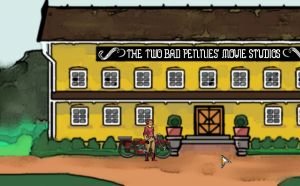 Grok and HandsFree have very much captured the spirit of the Roaring Twenties in Bad Trouble in the Red Desert. The graphics are largely presented in a watercolour style, though black lines have been used to give important characters and objects definition. You will visit such contrasting locations as the studio’s prop-filled storeroom and the barren sands of the titular desert. Jacqueline herself is clad in a sensible period pilot’s outfit, complete with scarf. She is smoothly animated, though most of the other characters she meets are static. Backgrounds are full of detail, including many posters for the studio’s past successes. The musical accompaniment is very much in keeping with the setting, being a variety of silent film music that changes to suit the current location and action.
Grok and HandsFree have very much captured the spirit of the Roaring Twenties in Bad Trouble in the Red Desert. The graphics are largely presented in a watercolour style, though black lines have been used to give important characters and objects definition. You will visit such contrasting locations as the studio’s prop-filled storeroom and the barren sands of the titular desert. Jacqueline herself is clad in a sensible period pilot’s outfit, complete with scarf. She is smoothly animated, though most of the other characters she meets are static. Backgrounds are full of detail, including many posters for the studio’s past successes. The musical accompaniment is very much in keeping with the setting, being a variety of silent film music that changes to suit the current location and action.
Interaction is largely done with a single left mouse click. The cursor is a simple arrow most of the time, but when pointed at a hotspot it changes to a default action (usually look) and right-clicking cycles through the other possible interactions for that hotspot. At the start you will merely be delivering films and props, though locating these is not as easy as it first appears. Later you will investigate the injury of stuntman and uncover a conspiracy that goes beyond the studio. Along the way you will need to crack a written code and gain access to a secret club, a task that requires multiple clicks for each individual action. There is a hint system in the menu bar, which will give you two hints per puzzle, one subtle and one blatant. There are also a couple of arcade sequences, though they come with an option to skip if so desired. You will have extensive conversations with the various characters, ranging from danger-loving stuntmen to an old rich banker who is unhappy that his daughter wants to be an actress. The plot moves along nicely, emulating the adventure films that inspired it.
Jacqueline White: Bad Trouble in the Red Desert can be downloaded from the AGS website.
The Lone Planet
Michael Starmik always felt like there was something missing from his life. When the chance to enlist in a scientific expedition going beyond the solar system came about, he was all too ready to sign up. True, he was only able to achieve a lowly rank, but he was still excited to be travelling out into space. Then one day, whilst relaxing in his quarters, he feels a terrible impact across the ship when it is struck by an asteroid, suffering severe damage across all decks. If Michael is to survive, he must make his way to an escape pod quickly. But first he needs to work out how to open the jammed doors of his quarters.
 In The Lone Planet, CNC Acolythe puts the player right in the middle of a major disaster. The graphics are displayed in moderately low-resolution, with both characters and backgrounds being noticeably pixelated. However, good use of colour has been made to distinguish different parts of the scenery, so items are easy to spot. You start off in your one-room quarters, which have survived the impact largely unscathed. Once you have escaped your initial confinement, you find the rest of the ship has not fared so well, with collapsed corridors and some parts open to space. Background noise is mostly a low rumbling as of remote machinery, though some areas have dramatic sci-fi music. There are plentiful sound effects throughout, including the crackling of damaged electronics and the hiss of pneumatic doors.
In The Lone Planet, CNC Acolythe puts the player right in the middle of a major disaster. The graphics are displayed in moderately low-resolution, with both characters and backgrounds being noticeably pixelated. However, good use of colour has been made to distinguish different parts of the scenery, so items are easy to spot. You start off in your one-room quarters, which have survived the impact largely unscathed. Once you have escaped your initial confinement, you find the rest of the ship has not fared so well, with collapsed corridors and some parts open to space. Background noise is mostly a low rumbling as of remote machinery, though some areas have dramatic sci-fi music. There are plentiful sound effects throughout, including the crackling of damaged electronics and the hiss of pneumatic doors.
Control is handled by left-click, with right-click cycling through walk, interact, look and talk options. These same actions can be selected from a menu at the bottom of the screen, where the inventory is also situated. You have two main problems in accessing other areas of the ship. Firstly, many doors are damaged or sealed, requiring you to find alternative ways of getting past them. You are also one of the lowest ranking crew members, thus having only limited access in the first place. Fortunately a robot and another crew member have survived, and both are able to aid you. You also gain a utility kit which contains general tools that are useful in a variety of situations. The overall tone of the adventure is humorous, though given the death and destruction around you this is slightly black in tone. It is also possible to die, though only by taking risky actions, so saving regularly is advisable.
The Lone Planet can be downloaded from the AGS website.
Escape the Game
The last thing the influential videogame critic remembered was a particularly horrendous looking game loading up on his computer. Suddenly he finds that he has fallen into that very game. The only way back to his real life is to achieve the game’s ultimate goal of becoming a Wizard-Hero-Pirate-King. But this game is full of bugs, often quite literally, and the quest might actually be impossible to achieve. Perhaps using his outside knowledge of how games work will aid him in this insane quest.
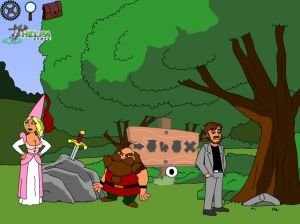 With Escape the Game, Helpa Games have created a fun if somewhat surreal experience. The graphics feature a bright cartoon style, with characters appearing slightly stylised but properly proportioned. The lead character is a man with a ponytail and beard in a grey suit, an outfit that is not entirely appropriate for what awaits him. Much of the game is set in a deliberately generic fantasy realm, with a big castle and a forest with dwarves and trolls residing in it. You will also visit the Pirate Bay, home to an oddly familiar character, where it is always night. The characters in these locales are simply but effectively animated, and the critic has a wide variety of movements and expressions. The music changes with the location: the main fantasy section has a gentle folksy guitar piece, whilst the Pirate Bay has a tune that feels appropriate to its particular resident. There are also a handful of sound effects, including a repeated scream from the protagonist.
With Escape the Game, Helpa Games have created a fun if somewhat surreal experience. The graphics feature a bright cartoon style, with characters appearing slightly stylised but properly proportioned. The lead character is a man with a ponytail and beard in a grey suit, an outfit that is not entirely appropriate for what awaits him. Much of the game is set in a deliberately generic fantasy realm, with a big castle and a forest with dwarves and trolls residing in it. You will also visit the Pirate Bay, home to an oddly familiar character, where it is always night. The characters in these locales are simply but effectively animated, and the critic has a wide variety of movements and expressions. The music changes with the location: the main fantasy section has a gentle folksy guitar piece, whilst the Pirate Bay has a tune that feels appropriate to its particular resident. There are also a handful of sound effects, including a repeated scream from the protagonist.
Progress is achieved using a simple left-click interface. When you point at a hotspot, the cursor changes to an appropriate action icon, most often look. After examining an object, you will usually get a different icon for further interaction, such as picking the item up. The game pokes fun at various genre conventions. In the opening tutorial, the lead character protests having to perform all the tutorial actions to continue. Elsewhere, a guide character moans about having to sit in the same place the whole time. Even the menu gets in on the fun, with the option to turn on voice acting suggesting you read the dialogue aloud in different voices. To succeed in your goal you will provide an odd answer to an equally bizarre riddle, navigate a short mystical forest maze, and fight a mighty champion (a turn-based mental challenge rather than a button-mashing obstacle). The dialogue is well written, with a tendency towards sarcastic humour.
Escape the Game can be played online at JayIsGames.
Hjarta
A cosmonaut is being sent out on a vital mission. Travelling alone, he will be the first to visit a new planet… A girl has been taken hostage by some thugs who are identified by individual letters. With a terrible fate awaiting her if she stays, she must seek a way out of this captivity... A synthetic being and his companions are prisoners aboard a transport. They must use their superior thinking power to outwit the organic creatures that hold them... Three stories. Three views of the future.
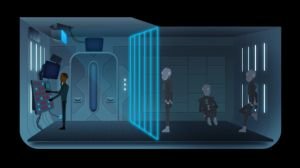 Whilst they feel part of the same world, the three stories Eight Bit Skyline present in Hjarta are entirely standalone tales, with no overt connections between them. The graphics are mostly made up of solid blocks of colour with simple graduated shading in places. Despite this relatively basic art style, it includes more than enough detail to make the important parts of the scenery stand out. As the cosmonaut you travel to a strange red planet, with a single monolithic building on the surface. As the girl you are trapped in a small attic room on top of a slightly seedy apartment. As the prisoner you are in a two-level vehicle that’s travelling across a barren landscape. All three stories are backed up by classical pieces from Grieg, Berlioz and Smetana. There are also a handful of sound effects, mostly related to machinery.
Whilst they feel part of the same world, the three stories Eight Bit Skyline present in Hjarta are entirely standalone tales, with no overt connections between them. The graphics are mostly made up of solid blocks of colour with simple graduated shading in places. Despite this relatively basic art style, it includes more than enough detail to make the important parts of the scenery stand out. As the cosmonaut you travel to a strange red planet, with a single monolithic building on the surface. As the girl you are trapped in a small attic room on top of a slightly seedy apartment. As the prisoner you are in a two-level vehicle that’s travelling across a barren landscape. All three stories are backed up by classical pieces from Grieg, Berlioz and Smetana. There are also a handful of sound effects, mostly related to machinery.
The three different characters can be played in any order by clicking one of their portraits when the game starts or after completing a story. Choosing one enters that story, with the option to continue if you have played part of it already. Control is performed through simple point-and-click; left-click interacts while right-click examines. The cosmonaut must operate his damaged spaceship and determine how to use some alien devices. The girl has to improvise with the limited materials on hand to escape the gang that has captured her. The synthetic prisoner and its companions need to work together to take over the vehicle carrying them. In this section, interacting with cellmates causes them to take appropriate actions to advance your collective cause. Inventory is stored in the menu bar at the top of the screen, and can be selected for use on hotspots. The menu bar also contains a help button which will give a progressive series of hints to the current puzzle if you are stuck. The overall tone is one of serious science-fiction.
Hjarta can be downloaded from the AGS website.
The Darkest Woods
Waking up in the forest with a head wound is never a good thing. But with these woods apparently crawling with malevolent entities, the situation is worse than you would have imagined. These horrors appear to be centred around an old abandoned hotel in the middle of the woods. As you uncover the history of this place, the reason for these disturbances become more apparent to you. Can you lay its dark history to rest, or will you become just another victim of the evil forces at work here?
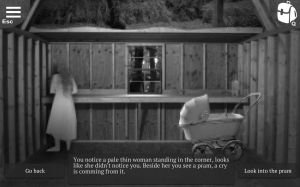 With a title like The Darkest Woods you’d expect a horror game, and Martadello does not disappoint. The graphics are black and white, apparently based on photographs and sometimes pieced together from more than one source. You will travel from the titular woods to the forbidding hotel whose interior has seen better days. These locations are inhabited by a variety of wraiths that often initially appear as shadowy figures or otherwise indistinct apparitions. Animation is limited but effective, frequently used to disquiet players by having something move unexpectedly. Background sound is mostly ambient, such as the rustling of trees and some bird noise. In some areas there are more disturbing noises like whispering voices, and there are brief bursts of music during certain tense scenes. There are also sound effects for most actions you perform. The game includes some audio tapes, all of which are voiced to a decent standard. The text has some translation issues, but none are severe enough to affect comprehension.
With a title like The Darkest Woods you’d expect a horror game, and Martadello does not disappoint. The graphics are black and white, apparently based on photographs and sometimes pieced together from more than one source. You will travel from the titular woods to the forbidding hotel whose interior has seen better days. These locations are inhabited by a variety of wraiths that often initially appear as shadowy figures or otherwise indistinct apparitions. Animation is limited but effective, frequently used to disquiet players by having something move unexpectedly. Background sound is mostly ambient, such as the rustling of trees and some bird noise. In some areas there are more disturbing noises like whispering voices, and there are brief bursts of music during certain tense scenes. There are also sound effects for most actions you perform. The game includes some audio tapes, all of which are voiced to a decent standard. The text has some translation issues, but none are severe enough to affect comprehension.
Saving often is recommended, as death can come abruptly right from the start. All interaction is done through simple left-click, with on-screen buttons showing what exits are available from each area. Inventory is held in a backpack in the top-left of the screen; clicking on this toggles a bar showing the objects you hold. Inventory items can be highlighted, causing them to be used for all future interactions until you de-select them. You will repeatedly need to work out how to placate or otherwise dispose of the various monsters that block your progress. In the hotel, most rooms are locked, requiring you to locate a key or find an alternative method of unsealing them. The audio tapes and some hand-written notes provide clues to the locations of hidden items and lock combinations. There are also times when you need to act quickly to save yourself from attack, though lightning-quick reflexes are not required.
The Darkest Woods can be downloaded from Game Jolt and is available for Windows, Mac and Linux.
Willem’s Winners
Bitstream
You are a hacker in a world where most people, including you, totally depend on canned oxygen to live. You attempt to break into the computers of a mysterious organization to bring it down, even if you don’t know why in the beginning – you will only find that out later. Complicating matters is that your oxygen supply is limited. Can you hack fast enough to penetrate deep into the organization’s computer and reveal its secrets?
 Nathan Hamley’s Bitstream is very different from other adventure games you may have played, which will be obvious right from the start. As the unseen protagonist, you will directly view a very old, black-and-white-and-greyish-green computer screen that shows the contents of the directories you are perusing. This consists of text most of the time as you read through files and emails and solve puzzles, but you will also view some strange monochromatic video clips. Your health status, heart rate and contents of your oxygen bottles are listed at the bottom of your own computer screen. Accompanying the visual display are noises that sound like 1980s computer music, the sound of a modem dialing, talking voices and static, which add greatly to the atmosphere. You often hear yourself breathing as well, especially when your oxygen starts running low, which makes the game even more intense.
Nathan Hamley’s Bitstream is very different from other adventure games you may have played, which will be obvious right from the start. As the unseen protagonist, you will directly view a very old, black-and-white-and-greyish-green computer screen that shows the contents of the directories you are perusing. This consists of text most of the time as you read through files and emails and solve puzzles, but you will also view some strange monochromatic video clips. Your health status, heart rate and contents of your oxygen bottles are listed at the bottom of your own computer screen. Accompanying the visual display are noises that sound like 1980s computer music, the sound of a modem dialing, talking voices and static, which add greatly to the atmosphere. You often hear yourself breathing as well, especially when your oxygen starts running low, which makes the game even more intense.
Before you proceed very far, you’ll need some crucial information that you will not get from the game itself, so pay close attention at the start to find out where to get it. Very old computers don’t use mice, so you’ll need to make do with the keyboard instead. You use the arrow keys to move the blinking cursor, and both the letter and number keys to input data. Finding your way in the computer’s elaborate directory tree is a puzzle in itself, especially at the end of the game. To access certain files and directories, you will have to solve puzzles involving the manipulation of symbols. But before you can even do that, you’ll first need to figure out what you’re required to do. This takes time, and you will almost certainly fail to finish the game on time in your first couple tries. Fortunately, the computer does most of the actual “hacking” for you, so you don’t need any programming skill to play Bitstream. You do get a sense of what hacking a computer feels like, however, as examining data you’re not supposed to see provides a certain thrill that makes this game fun to play.
When you finish the game you can start on the last (figurative) puzzle: what does it all mean? You only get tiny bits and pieces of information here and there as you play, and only after completing Bitstream will you have enough information to piece the story together. The fact that you can only flesh out the details after playing the game was to me a very new and refreshing concept. All in all, Bitstream may not be for everyone, but it’s definitely worth a try if you want to explore your hidden hacking skills.
Bitstream can be downloaded from the developer’s website.
Vortex Point: Time of your life Carnival
In the sixth installment of the Vortex Point series by Carmel Games, the local ghost hunting team receives a phone call from Vince Nordkov, a famous collector of cursed and bewitched items. He reports that a small African statue has been stolen from him by a ten-year-old boy with a patch over his left eye. Going solo this time, Kevin is on the case and will not rest until he finds the boy and the statue.
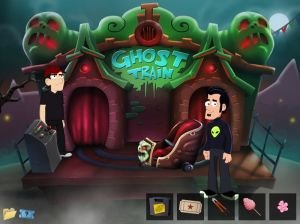 As we have come to expect from this developer, Vortex Point: Time of your life Carnival is presented in a cartoon style using bright colors with virtually no straight or parallel lines. Most of the characters look cheerful even though this game is full of weird and dangerous looking objects. Along with Vince’s collection, the titular carnival claims to be filled with mysterious and rare items – whether that is true remains to be seen, but there is certainly something strange about this place. The group’s headquarters also has its share of paranormal stuff, like the demonic doll Danabelle, a Ouija board and a magic 8-ball that floats around the office. The characters are excellently voiced, and subtitles are shown in a black bar at the top of the screen that only vanishes when you click. The action is accompanied by mysterious music that repeats itself, but not so much that it becomes too annoying.
As we have come to expect from this developer, Vortex Point: Time of your life Carnival is presented in a cartoon style using bright colors with virtually no straight or parallel lines. Most of the characters look cheerful even though this game is full of weird and dangerous looking objects. Along with Vince’s collection, the titular carnival claims to be filled with mysterious and rare items – whether that is true remains to be seen, but there is certainly something strange about this place. The group’s headquarters also has its share of paranormal stuff, like the demonic doll Danabelle, a Ouija board and a magic 8-ball that floats around the office. The characters are excellently voiced, and subtitles are shown in a black bar at the top of the screen that only vanishes when you click. The action is accompanied by mysterious music that repeats itself, but not so much that it becomes too annoying.
The entire game is played using only the left mouse button, and most of the puzzles are inventory-based. The inventory is in the lower right of the screen, while in the bottom left corner are buttons that send you to the game’s menu and a walkthrough. Amongst other goals, you’ll undertake a fetch quest and a task involving a riddle that is far more complicated than normal for Carmel. The Vortex Point series contains some of the best games this studio has made, and the latest installment is once again quite good. Not only are the puzzles a bit more complex than we are used to, but the story itself is a bit more elaborate than usual. It still isn’t long or particularly challenging, but it definitely makes for a fun 20 minutes.
Vortex Point: Time of your life Carnival can be played online at JayIsGames.
Other new releases
Not all games are created equal, and freeware games especially come in all shapes and sizes. Not to be overlooked, the following list might also be of interest, though these games may be significantly shorter or less polished, more experimental titles than those detailed above, some perhaps only borderline adventures to begin with.
Ten weeks by Leaf Thief – When a woman suffers a stroke, the subsequent ten weeks are full of confusion.
Cornelius Cat in The Uncontrollable Pest by cat – A feline sleuth takes on the case of the creature that has been eating all the locals’ vegetables behind their backs.
The Cold Hand Reef by WHAM – Though the fishing may be good out there, there's a reason boats don’t go out to the eponymous reef.
Dislocation by Team Dislocation – A murder investigation in a hidden lab turns up a strange quantum device.
Secret Agent Cinder by Emily Ryan – When she sneaked into the ball, it was secrets rather than a handsome prince that Cinderella was after.
That’s it for this month. Think we’ve missed a gem or want to tell us about your own game? Then pop in to our Adventure forum and tell us about it!
Article written by Stephen Brown and Willem Tjerkstra.




